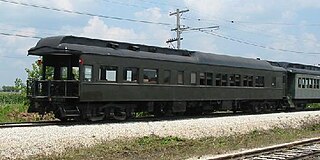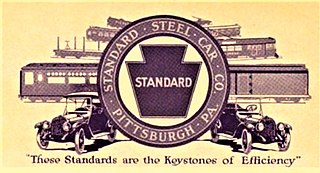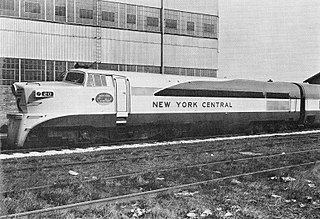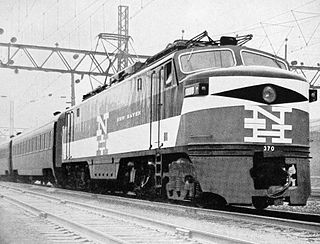
American Flyer is a brand of toy train and model railroad, originally manufactured in the United States.

A streamliner is a vehicle incorporating streamlining in a shape providing reduced air resistance. The term is applied to high-speed railway trainsets of the 1930s to 1950s, and to their successor "bullet trains". Less commonly, the term is applied to fully faired upright and recumbent bicycles. As part of the Streamline Moderne trend, the term was applied to passenger cars, trucks, and other types of light-, medium-, or heavy-duty vehicles, but now vehicle streamlining is so prevalent that it is not an outstanding characteristic. In land speed racing, it is a term applied to the long, slender, custom built, high-speed vehicles with enclosed wheels.

The Pullman Company, founded by George Pullman, was a manufacturer of railroad cars in the mid-to-late 19th century through the first half of the 20th century, during the boom of railroads in the United States. Through rapid late-19th century development of mass production and takeover of rivals, the company developed a virtual monopoly on production and ownership of sleeping cars.

The Broadway Limited was a passenger train operated by the Pennsylvania Railroad (PRR) between New York City and Chicago. It operated from 1912 to 1995. It was the Pennsylvania's premier train, competing directly with the New York Central Railroad's 20th Century Limited. The Broadway Limited continued operating after the formation of Penn Central (PC) in February 1968, one of the few long-distance trains to do so. PC conveyed the train to Amtrak in 1971, who operated it until 1995. The train's name referred not to Broadway in Manhattan, but rather to the "broad way" of PRR's four-track right-of-way along the majority of its route.

The Super Chief was one of the named passenger trains and the flagship of the Atchison, Topeka and Santa Fe Railway. The then-modern streamliner was touted in its heyday as "The Train of the Stars" because it often carried celebrities between Chicago, Illinois, and Los Angeles, California.

An observation car/carriage/coach is a type of railroad passenger car, generally operated in a passenger train as the rearmost carriage, with windows or a platform on the rear of the car for passengers' viewing pleasure. The cars were nearly universally removed from service on American railroads beginning in the 1950s as a cost-cutting measure in order to eliminate the need to "turn" the trains when operating out of stub-end terminals.

The Prospector was a passenger train operated by the Denver & Rio Grande Western railroad between Denver, Colorado and Salt Lake City, Utah. There were two incarnations of the train: a streamlined, diesel multiple unit train that operated briefly in 1941 and 1942; and a locomotive-hauled train of conventional passenger equipment that operated from 1945 until 1967.

The Budd Company was a 20th-century metal fabricator, a major supplier of body components to the automobile industry, and a manufacturer of stainless steel passenger rail cars, airframes, missile and space vehicles, and various defense products.

The Standard Steel Car Company (SSC) was a manufacturer of railroad rolling stock in the United States that existed between 1902 and 1934.

The Capitol Limited was an American passenger train run by the Baltimore and Ohio Railroad, originally between New York City and Grand Central Station in Chicago, via Washington Union Station in Washington, D.C., Camden Station in Baltimore, and Pittsburgh. For almost 48 years, it was the B&O's flagship passenger train, noted for personalized service and innovation. At the time of its discontinuation on May 1, 1971, when Amtrak took over most rail passenger service in the U.S., the Capitol Limited operated between Washington and Chicago.

Otto August Kuhler was an American designer, one of the best known industrial designers of the American railroads. According to Trains magazine he streamstyled more locomotives and railroad cars than Cret, Dreyfuss and Loewy combined. His extensive concepts for the modernization of the American railroads have repercussions onto the railways worldwide until today. In addition he was a prolific artist of industrial aesthetics and of the American West in general.
The Birmingham Railway and Electric Company was both a streetcar and electricity provider in Birmingham, Alabama, US.

The East Wind was a summer passenger train between Washington, D.C., and resorts along the southern Maine coast. Travel time was about 11.5 hours over the 700-mile (1,100 km) route to Portland, Maine in 1941. Travel time was later reduced to 8 hours by 1955 although it terminated in New York City. The route was over the Pennsylvania Railroad from Washington through Philadelphia to New York City, then the New Haven Railroad to Groton, Connecticut, where it left the Northeast Corridor to reach the Boston and Maine Railroad at Worcester, Massachusetts, whereby it continued northeastward, bypassing Boston. The train continued over the Boston & Maine to Portland, where a coach and diner continued to Bangor, Maine, on the connecting Pine Tree Limited. In contrast to the other Mid-Atlantic to Maine trains, it was the only day and evening train.

The RP-210 was a streamlined 1,000 hp (750 kW) locomotive built in 1956 by Baldwin-Lima-Hamilton, specifically to operate with the experimental, all-aluminum Train-X coaches that were built by the Pullman-Standard Car Manufacturing Company. The model represented Baldwin's attempted entry into the lightweight passenger locomotive market, but only three of the low-slung diesel-hydraulic units were produced. The first RP-210 was built for the New York Central Railroad to power their Ohio Xplorer train between Cleveland, Columbus, and Cincinnati, and a pair was purchased by the New York, New Haven and Hartford Railroad to double-end their Dan'l Webster, running between New York City and Boston.
The Gull was an international passenger train service between Boston, United States, and Halifax, Canada, which operated from 1930 to 1960. Journey time was approximately 24 hours. Westbound trains left Halifax shortly after breakfast and crossed the Canada–United States border in the late evening, as eastbound trains were leaving Boston's North Station to cross the border about dawn. Travel was over the Boston and Maine Railroad from Boston to Portland, Maine, then over the Maine Central Railroad to the border between Vanceboro, Maine, and Saint Croix, New Brunswick, then over the Canadian Pacific Railway to Saint John, New Brunswick, and over the Canadian National Railway to Halifax.
The streamliner cars are a class of streamlined passenger railroad cars built from the 1930s through the 1960s for long distance passenger train services in North America.
The Pittsburgher was an overnight limited passenger train operated by the Pennsylvania Railroad between New York City and Pittsburgh, Pennsylvania over the Pennsylvania's Main Line. It operated from 1924 to 1964 and one of the most prestigious trains operated by the Pennsylvania and perhaps the premier train between New York and Pittsburgh.

The Overland Limited was an American named passenger train which for much of its history was jointly operated by three railroads on the Overland Route between San Francisco and Chicago. The Southern Pacific Railroad handled the train west of Ogden, Utah, the Union Pacific Railroad between Ogden and Omaha, Nebraska/Council Bluffs, Iowa, and east of the Missouri River to Chicago it was operated by the Chicago and North Western Railway as well as, for a few years starting in 1955, by the Chicago, Milwaukee, St. Paul and Pacific Railroad.

The American Flyer was an early streamlined American passenger railcar built by Pullman-Standard in the 1930s. They were the first streamlined equipment operated in New England and acquired their name from the model trains that their design inspired.
















